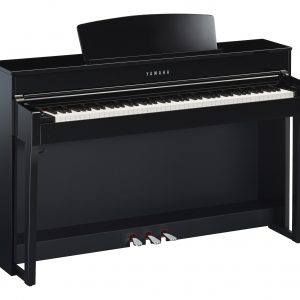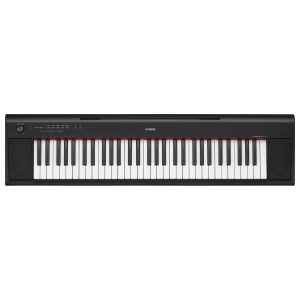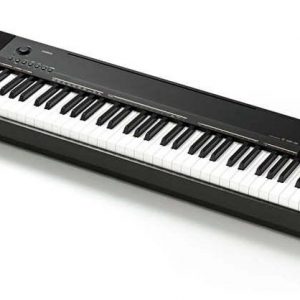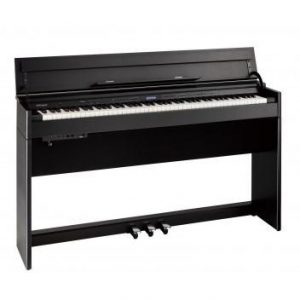Description
The Casio PX-870 is a digital piano reputed for its ultra-authentic sound and feel. Developed with simple designs and groundbreaking technology, this piano is a masterpiece that appeals to beginners and professional musicians alike.
Sound quality and realism are what make the Casio PX-870 stand out from the crowd. It comes equipped with a premium amplification system, a four-channel equalizer, and an advanced filtering system that suppresses all sound on the keyboard other than the one you are playing.
The PX-870 is built with Casio’s proprietary AiR sound engine, a technology that delivers authentic piano sounds that closely mimic the resonance, decay, and tonal variation of an acoustic piano. It also comes with a total of 19 different tone options, including grand pianos, electric pianos, harpsichords, organs, and more.
The piano has an 88-key weighted hammer-action keyboard that doesn’t feel like a digital keyboard, rather like a genuine piano. The keys are appropriately weighted, giving the pianist an authentic piano experience. Also, the keyboard is made up of synthetic ivory and ebony materials that give it an excellent grip.
There are benefits to owning a digital piano, especially when it comes to flexibility and versatility. The Casio PX-870 is equipped with numerous sound and recording features that make it an exciting instrument to play.
For recording, the PX-870 comes with a two-track recorder built-in that allows you to record, playback, and save moments of creativity. You can also layer different sounds on top of one another, effectively mixing up to four different sounds for a new tone.
The piano also comes with an Accompaniment System that enables you to play along with MIDI files or other audio tracks. You can, therefore, create full arrangements with drums or bass accompaniments that give you an enriched music experience.
Lastly, the PX-870’s design is simple, clean, and elegant. It comes in a black, rosewood, or white finish, depending on your preferences. Additionally, it comes with a sliding key cover that can protect the keyboard when not in use.
In conclusion, the Casio PX-870 is a modern digital piano that combines superior technology and design to deliver the ultimate playing experience. Its lightweight, streamlined design makes it perfect for small living spaces, and the sound quality, combined with the weighted keys, makes it feel like you’re playing an acoustic upright. If you’re a beginner or an experienced pianist, this piano is a top pick that you won’t regret.
Casio PX-870 properties
| Product name | PX-870 |
| Brand | Casio |
| Type | Keyboard Instruments |
| Keyboard Instrument | Stage and Digital Piano |
| Keys | Yes |
| Number of Keys | 88 pcs |
| Colour | Black |






Leo Fennimore –
And one more note: it’s best to get over and buy an instrument with an original pedal bar. Such a strip is 1000 times better than the plastic sustain pedal included in the set. The squeaking of the pedals stops after about 2 weeks of use, when they are well formed and settle down.
Besides, in this price range, the instrument is fine
Gene Grant –
I am not a professional musician, but for me this piano is very good, both in terms of the sound and the quality of the keyboard. After switching to a CASIO keyboard, this is a huge plus. The number of functions and sounds is limited, but all that matters is and works perfectly.
A certain difficulty is that access to most of the functions requires pressing a combination of several keys and without the manual, there is no way to remember.
Waylon Barron –
The intriguing world of finance, where even the most seasoned investors can be left bewildered by the whimsical nature of cash flows. It’s as if the market is playing a game of musical chairs, and those who dare to venture off the sidelines may find themselves left holding an empty seat.
But, I digress. As I sit here sipping my morning coffee, pondering the mysteries of the universe, I am reminded of a most wondrous experience from my recent vacation. While strolling through the quaint streets of Hampton, Virginia, I chanced upon a store that would change my life forever – or at least, my musical endeavors. The store, located at 550 Settlers Landing Rd, boasted an impressive array of electronic instruments, but none caught my eye quite like the Casio PX-870 Stage and Digital Piano.
As I gazed upon this marvel of modern technology, I couldn’t help but feel a sense of awe wash over me. This wasn’t just any piano; it was a masterpiece of innovation, a symphony of sound that defied the boundaries of traditional music-making. The Casio PX-870 is a product type that falls under the Keyboard Instruments category, and trust me when I say that it’s an experience unlike any other.
What sets this digital piano apart from its analog counterparts? For starters, its triple sensor keyboard technology ensures that every note played is a perfect replica of its acoustic counterpart. The sound quality is nothing short of breathtaking – rich, resonant, and full of depth. But what truly sets the PX-870 apart is its ability to mimic the expressive qualities of an acoustic piano. With 18 sounds, including grand piano, electric piano, and even a mighty cathedral organ, this digital piano is capable of evoking emotions that would put even the most skilled pianists to shame.
As I sat down to play, I couldn’t help but think of today’s news – Cash doesn’t always come off the sidelines: Morning Brief. Cash on the Sidelines: Not a Reliable Indicator of Future Market Gains. The market’s volatility is nothing new, but as an investor, it’s essential to stay adaptable and make informed decisions based on data-driven insights.
In much the same way that the Casio PX-870 adapts to the nuances of music-making, investors must be willing to pivot when the market landscape changes. It’s a delicate dance between risk and reward, where even the slightest misstep can have disastrous consequences.
But I digress. The Casio PX-870 Stage and Digital Piano is an investment in itself – an investment in your musical journey, your creative expression, and your very soul. As I continue to explore the depths of this incredible instrument, I am reminded that sometimes, it’s not about making a profit; it’s about creating something truly remarkable.
In short, if you’re looking for a digital piano that will leave you breathless and wanting more, look no further than the Casio PX-870. It’s an experience unlike any other, a symphony of sound that will leave even the most seasoned investors in awe. And who knows? You might just find yourself investing in your musical future, one note at a time.